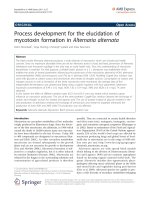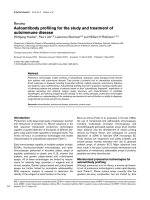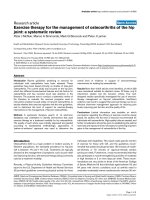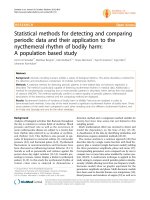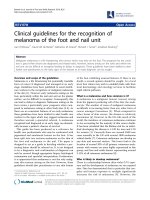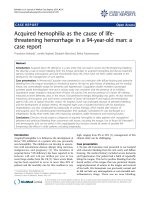Báo cáo y học: "Further cautions for the use of ventilatory-induced changes in arterial pressures to predict volume" docx
Bạn đang xem bản rút gọn của tài liệu. Xem và tải ngay bản đầy đủ của tài liệu tại đây (114.94 KB, 2 trang )
Ventilatory-induced variations in arterial pulse pressure
(PPV) are widely used to predict whether a patient is
volume responsive, but they have important limitations.
Wyler and colleagues add pulmonary hypertension as
another limitation [1]. e authors should be com-
mended for not stopping with their clinical observation,
confi rming this in an animal model that – although
somewhat diff erent from the clinical condition – allowed
controlled conditions [2]. Ventilatory variations in
arterial pressure were proposed over 20 years ago [3] and
algorithms for their use are now included in a number of
monitoring devices. Important to remember, however, is
that these indicators are only useful if prerequisites are
met – including the absence of any spontaneous
ventilatory eff orts, a regular rhythm, and ventilatory
settings similar to those in the original studies. e
current studies add another limitation and importantly
indicate that indiscriminant use of these indicators can
lead to excessive fl uid use.
I have argued previously [4] – and still believe – that
the dominant process causing ventilatory-induced fl uctu-
ations in arterial pressure that are fl uid responsive is that
when the heart is functioning on the steep volume-
responsive part of the cardiac function curve, the
inspiratory rise in pleural pressure transiently decreases
return of blood to the right heart. is decrease in fl ow is
passed to the left side of the circulation during expiration.
When the heart is functioning on the fl at nonvolume-
responsive part of the cardiac function curve, a fall in
cardiac fi lling is less marked. is mechanism dominates
because the pressure gradient from the large systemic
venous reservoir to the right heart is only 4 to 8 mmHg
so small changes in pleural pressure can have a major
eff ect on venous return.
Since the normal gradient for venous return is small,
even small increases in pleural pressure might be
expected to reduce cardiac output to zero – yet observed
decreases in pulse pressure and stroke volume are much
more modest. is observation occurs because pulmo-
nary blood volume provides a reserve that can tempor-
arily maintain left-sided cardiac fi lling. e volume in the
pulmonary vasculature, the respiratory rate, and the
heart rate determine the magnitude of this buff ering
eff ect.
During inspiration, lung infl ation also squeezes volume
from the pulmonary veins and decreases left ventricular
afterload [5-7]. ese two factors produce a transient
increase in left ventricular ejection, and account for the
inspiratory increase in pressure relative to the value at
end-expiration (dUp) in arterial pressure variations [4],
but this component has little volume sensitivity. is lack
of sensitivity is because the thoracic vascular compliance
is only one-seventh that of the systemic vascular
compliance and a change in total body volume adds only
a small amount of volume to this compartment. Yet this
small volume, when transferred to the arterial side, has a
large pressure eff ect because of the low arterial
compliance.
Abstract
Variations in systemic arterial pressure with positive-
pressure breathing are frequently used to guide
uid management in hemodynamically unstable
patients. However, because of the complex physiology
that determines the response, there are important
limitations to their use. Two papers in a previous
volume add pulmonary hypertension as limitations.
Uncritical use of ventilatory-induced changes in arterial
pressure can lead to excessive volume therapy and
potential clinical harm, and they must be used with
respect and thought.
© 2010 BioMed Central Ltd
Further cautions for the use of ventilatory-induced
changes in arterial pressures to predict volume
responsiveness
Sheldon Magder*
See related research by Wyler et al., and related research by Daudel et al.,
/>COMMENTARY
*Correspondence:
Royal Victoria Hospital, 687 Pine Avenue West, Montreal, Quebec, Canada H3A 1A1
Magder Critical Care 2010, 14:197
/>© 2010 BioMed Central Ltd
ere are other mechanisms that can produce PPV
with positive pressure ventilation. Veiellard-Baron and
coworkers [8] showed that inspiratory loading can signi-
fi cantly reduce right ventricular output. is can be
explained as follows. When the lung is in West Zone III,
lung infl ation produces a negligible load on the right
ventricle [5]; but when it is in West Zone II, lung infl ation
can markedly decrease right ventricular output, increase
pulmonary vascular volume and transiently decrease left
ventricular fi lling [9]. e consequent decrease in left
ventricular output can produce very large swings in
arterial pressures, but these swings should be minimally
responsive to volume infusion because they are minimally
related to right heart fi lling.
Based on the above analysis, how can the poor predic-
tive values of PPV in the studies by Wyler and colleagues
[1] and by Daudel and colleagues [2] be explained? eir
plots of stroke volume against central venous pressure
indicate that stroke volume was responsive at some point
even in the endotoxin group and there was a lot more
volume responsiveness than seems to show up in the
results. One factor could be simply technical. e authors
used the standard 10% change in stroke volume. After
hemorrhage this would mean a change in stroke volume
of only 1 to 2 ml versus 10 ml in the control animals at
their peak. Yet a 1 ml change in end-diastolic volume
from any initial value should produce a 1 ml change in
stroke volume. e use of percentage change could thus
have obscured what was happening, especially consider-
ing that there were progressive increases in the stroke
volumes.
Two other factors also might be involved. First, dUp
probably accounted for a signifi cant part of the PPV. dUp
is related to the decrease in afterload with a positive
pressure breath and the squeezing of blood out of the
lungs. Afterload reduction has a greater eff ect when
ventricular function is decreased, as in sepsis; and,
secondly, more volume can be squeezed from the lung if
pulmonary blood volume was increased in the septic
animals. Further more, the afterload reducing eff ect is
related to how much pleural pressure rises with each
breath, and pleural pressure would have been increased if
chest wall compliance was reduced by edema from
volume loading. Second, lung injury associated with
sepsis probably increased the presence of zone II
conditions in the lungs, so this cause of PPV is not
volume responsive.
ese studies further emphasize the limited usefulness
of ventilatory-induced changes in arterial pressure for
predicting volume responsiveness. ere are so many
factors that can aff ect the phenomena that the technique’s
use should be reserved for very limited controlled
conditions such as in the operating room. e authors’
warning about potential harm from excess use of fl uids if
these measurements are used too casually needs to be
heeded. Finally, it is always worth emphasizing that even
if PPV does predict volume responsiveness, it does not
mean that the patient actually needs volume or that
volume is the best management choice.
Abbreviations
dUP, inspiratory increase in pressure relative to value at end-expiration; PPV,
pulse pressure variation.
Competing interests
The author declares that he has no competing interests.
Published: 20 September 2010
References
1. Wyler MvB, Takala J, Roeck M, Porta F, Tueller D, Ganter CC, Schröder R, Bracht
H, Baenziger B, Jakob SM: Pulse-pressure variation and hemodynamic
response in patients with elevated pulmonary artery pressure: a clinical
study. Crit Care 2010, 14:R111.
2. Daudel F, Tueller D, Krahenbuhl S, Jakob SM, Takala J: Pulse pressure
variation and volume responsiveness during acutely increased pulmonary
artery pressure: an experimental study. Crit Care 2010, 14:R122.
3. Perel A, Pizov R, Cotev S: Systolic blood pressure variation is a sensitive
indicator of hypovelemia in ventilated dogs subjected to graded
hemorrhage. Anesthesiology 1987, 67:498-502.
4. Magder S: Clinical usefulness of respiratory variations in arterial pressure.
Am J Respir Crit Care Med 2004, 169:151-155.
5. Permutt S, Howell JBL, Proctor DF, Riley RL: E ect of lung in ation on static
pressure volume characteristics of pulmonary vessels. J Appl Physiol 1961,
16:64-70.
6. Bromberger-Barnea B: Mechanical e ects of inspiration on heart functions.
Fed Proc 1981, 40:2172-2177.
7. Howell JB, Permutt S, Proctor DF, Riley RL: E ect of in ation of the lung on
di erent parts of pulmonary vascular bed. J Appl Physiol 1961, 16:71-76.
8. Vieillard-Baron A, Prin S, Chergui K, Dubourg O, Jardin F: Echo-Doppler
demonstration of acute cor pulmonale at the bedside in the medical
intensive care unit. Am J Respir Crit Care Med 2002, 166:1310-1319.
9. Permutt S, Bromberger-Barnea B, Bane HN: Alveolar pressure, pulmonary
venous pressure, and the vascular waterfall. Med Thorac 1962, 19:239-260.
doi:10.1186/cc9223
Cite this article as: Magder S: Further cautions for the use of ventilatory-
induced changes in arterial pressures to predict volume responsiveness.
Critical Care 2010, 14:197.
Magder Critical Care 2010, 14:197
/>Page 2 of 2

